c6e79eedbcfc9ea8afda02d82a958982.ppt
- Количество слайдов: 66

Distributed Security -- Issues & Technology Solutions

Learning Objectives • Clarify need for distributed security (what are we trying to protect? ) • Identify fundamental security objectives • Review basic network attacks • Classify typical attackers • Examine technical safeguards • Explore firewall options

Internet Security Needs • “While non-technical publications are obsessed with the Internet, technical publications are obsessed with security” Chapman & Zwick, 1995 • Information view: marvelous technological advance in information dissemination with a major danger to pollute and destroy • Transaction view: major deterrent to EC growth

What do we Need to Protect? • Data § Information we keep on computers (product design, financial records, personnel data) § Lost time, lost sales, lost confidence • Resources § Unauthorized use of computer time & space • Reputation § Misrepresentation, forgery, negative publicity

Fundamental Security Objectives • Four fundamental objectives of Info Security § Confidentiality - Protection from unauthorized persons § Integrity - consistency of data; no unauthorized creation, alteration or destruction § Availability - ensuring access to legitimate users § Legitimate use - ensuring appropriate use by authorized users

Basic Security Attacks • Intrusion - unauthorized access and use of systems • Denial of service - an attack aimed at preventing use of company computers § email bomb or flooding/Internet worm § disabled, rerouted or replaced services • Information theft - network taps, database access, hacking info sites to give out more info or to wrong parties

Technical Safeguards • Security Services § § § Authentication (entity, data origin) Access control (prevent unauthorized access) Confidentiality (disclosure, encryption) Data integrity (value of data item) Non-repudiation (falsely denying a transaction)

Security Models • No Security - not an option • Security thru Obscurity - don’t tell anyone where your site is • Host Security - enforced security on each host; progressively difficult to manage as number of hosts increase • Network Security - control network access to hosts and services; firewalls, strong authentication, and encryption

Firewall Solutions • Definition - hardware &/or software components that restrict access between a restricted network & the Internet or between networks • Logically - a separator, restricter, analyzer • Rarely a single object § Restricts people to entering at a controlled point § Prevents attackers from getting close to other defenses (host controls) § Restricts people to leaving at a controlled point

Firewall Capabilities • Focus security decisions - single point to leverage control • Enforce security policy - minimize exceptions • Log Internet activity - analysis • Limit exposure - separate sensitive areas of one network from another or outside world

Firewall Limitations • Can’t protect against § malicious insiders § connections that don’t go through it § new threats § viruses • scans for source & destination addresses & port numbers, not details of data

Types of Firewalls • Simple traffic logging systems § audit log file of files accessed (HTTPD) § site usage/demand hours/links/browsers used • IP Packet Screening Routers (packet filtering gateway) § not only looks at ‘can’ it route, but ‘should’ it § selectively routes or blocks packets based on rules § based on protocols, destination (port 80), known source IP addresses

Types of Firewalls (cont. ) • Hardened Firewall Host (hardware) § Halts unauthorized users § Concentrates security, hides internal system names, centralizes & simplifies net management • Proxy Server (software) § Deals with external server requests on behalf of internal clients § May limit certain HTTP methods (CGI or Java applets)

Common Solutions • Screened Host § Host attached to internal network using separate router § Internal host is only internal system that net hosts can connect to § Packet filtering configuration determines if internal hosts may connect to other external hosts Internet Firewall Screening Router Internal Network

Common Solutions (cont. ) • Firewall Architectures § Dual-homed host (two network interfaces) • One communicates externally, one internally • No direct communication internal to external hosts Internet Real Server Dual-homed Host Proxy Server Proxy Client/Internal Host

Common Solutions (cont. ) • Screened Sub-Net Architecture § Extra layer of security over screened host § Perimeter network further isolates the internal network from the Internet Internal (Bastion Host) (email, FTP, DNS) Perimeter Network External Router (access router) Internal Router/ (choke router) Internal Network

Other Variations • Multiple Bastion Hosts § Performance, redundancy, need to separate data & servers § Usenet, SMNP/DNS, FTP/WWW • Merge Interior & Exterior Routers § Sufficient capability to specify inbound & outbound filters § Usually on the perimeter network • Merge Bastion Host & Exterior Router • Use Multiple Exterior Routers § Multiple connections to Internet or Internet + other sites • Multiple Perimeter Nets § Redundancy, privacy

Not Recommended • Merging Bastion Host & Interior Router • Breach of host leaves access to internal net • Using Multiple Interior Routers • Routing software could decide fastest way to another internal system is via the perimeter net • Difficult to keep multiple interior routers configured correctly • Most important & complex set of packet filters • May need to use multiples to resolve performance bottlenecks or separate internal networks

Futures • Third-generation Firewalls § combined features of packet filtering & proxy systems • Client & server applications with native support for proxied environments • Dynamic packet filtering § Packet rules modified “on the fly” in response to triggers • Underlying Internet protocol undergoing revisions - IPv 6

Cryptography Basics

Learning Objectives • Identify requirements for secure communication • Discuss cryptographic techniques • Define cryptosystems & evaluate current encryption methods • Review digital signature standards • Discuss challenges of key management • Review other security options & trust

Secure EC requirements • For any network transaction: § 1. Privacy 2. Confidentiality 3. Integrity • For reliable, secure communication: 1. 2. 3. 4. Authentication- we are who we say we are Certification - guarantee by 3 rd party that ‘wawwswa’ Confirmation - digital receipt of transaction Nonrepudiation - binding agreement, digital proof of transaction 5. Encryption - for all of the above, encoded passage of information over open networks

Cryptographic Techniques • Secret writing or cryptic symbolization • Technique - encryption algorithm or cryptosystem § defines a pair of data transformations • • encryption and decryption encryption = plaintext to ciphertext both use ‘keys’ - seemingly random string key length (number of bits) dependent upon cryptosystem

Encryption Cryptosystems • Symmetric - private key systems (same key) • DES - Data Encryption Standard / 56 -bit key • Vulnerable to exhaustive key search (2 56 possibilities) • New standard in process Plaintext Encrypt Ciphertext Decrypt Plaintext

Encryption Systems (cont. ) • Asymmetric - public key systems (key pair) • 1976 - Stanford development § encryption mode: public key to private key § authentication mode: private key to public key § cryptosystems operating both ways called reversible • 1978 - RSA - reversible cryptosystem § based upon multiplication of two prime numbers § possible to crack via large computer resource § 1994 - 429 -bit code cracked by scientific collaboration after 17 years § requires continual updating of modulus to protect § Jaws Tech, Inc. 4, 096 -bit (100 years)

Digital Signature Standards • Accompanies a digitally encoded message § verifies originator of message § assures message not modified § satisfies non-repudiation requirement Plaintext Sign Verify Verifies? Signature Sender’s Private key Sender’s Public key

Digital Key Management • Life cycle management (cryptoperiod) • • • Generation & registration (random numbers) Distribution & Availability Key backup/recovery/key escrow Replacement or update Protection against disclosure Termination or archival (confidentially archived information must be accessible after key retirement)

Other Security Methods • Authentication Protocols built into communications protocol • • • transformed password (one-way function) challenge-response (random value rec’d/sent) time-stamp (synchronized clocks) one-time password (different variant each login) zero-knowledge technique (interactive proof) • Address-based Authentication (network address) • Personal Tokens (hardware & pw/ smart cards) • Biometrics (fingerprint, voiceprint, handwriting)

Kerberos • Complete authentication system - MIT § § § DES symmetric cryptography Online authentication servers Host server & clients share symmetric keys Client requests a ‘ticket’ / sends to server Ticket interpreted only by correct server Session key is generated by authentication server after successful exchange • Authentication service (AS) / Ticket-granting Service (TGS) / Client/Server (CS) authentication exchange

Internet Security • Three levels (Network, application, system) § Network - data packet integrity in-transit (Authentication/confidentiality/access controls) • IP layer/ headers + data = IP datagram • Not inherently secure (IP Spoofing - attacks w/false source addresses) • Authentication headers - integrity check values to indicate source & transit integrity of datagram § Security Association / Security Parameter Index

Internet Security (Network) • Packet Encryption - Encapsulating Security Payload (ESP) provides confidentiality + integrity § Algorithm (transforms) § Tunnel-mode encryption (entire datagram encrypted) § Transport-mode encryption (data only encrypted) • Key Management - no single standard § Host-oriented - all users share same association & key § Potential for decrypt another’s messages § User-oriented - user has 1 or more association & keys § Lower risk / Superior method • Firewalls - screening routers/proxy servers, perimeter networks

Internet Security (Network) § Virtual Private Networks (VPN) • Secure groups of network sites using Inet backbone § IP tunneling / firewalls • Messaging - special security needs above network measures § E-mail / mail enabled applications • Writer to reader protection via user agent • Message Transfer Agents (MTAs) = message transfer backbone (originating & delivering)

Internet Security (Messaging) • Basic Message Protection Services § Message origin authentication / content integrity / content confidentiality / nonrepudiation of origin • Enhanced Message Protection Services § Confirmation services (proof of delivery & submission, non-repudiation of delivery & submission) § Other - I. e. security labeling service

Internet Security (Messaging) • Secure Messaging Protocols § PEM - Privacy Enhanced Mail (basic services) • Wraps itself around standard mail message § MIME Security Multi-parts • Multi-purpose Internet Extensions - supports structuring of message body • Different body parts - text, image, audio, etc • 1995 specifications: § Security Multi-parts for MIME § MIME Object Security Services (MOSS) § Transforms messages into standard representation for transport

Internet Security (Messaging) • S/MIME - RSA alternative to MOSS spec § built upon Public-Key Cryptography Stds (PKCS) § Protects MIME body parts, w/new data structure that becomes MIME content § Signed, enveloped or both § Mailer must be S/M compliant to read • PGP (Pretty Good Privacy) free app using digital signatures & encryption § Defines own public key pair mgmt system § Casual e-mail, not wide-scale e-commerce

Internet Security (Messaging) • X. 400 Security § 1984/1988 international stds for mail gateways § Security features specific to X. 400 protocols § X. 400 secured mail cannot be conveyed over Inet • Message Security Protocol (MSP) § US/DOS protocol similar to S/MIME, PKCS § Encapsulates message for basic & some enhanced services

Message Protocol Comparison • S/MIME - strongest commercial acceptance • PGP - free; not compatible w/public-key infrastructure; scalability questionable • MSP - most comprehensive feature set; not commercially widespread • MOSS - compatibility issues w/public-key; weak commercial vendor acceptance • PEM - not compatible with MIME/outdated • X. 400 - most comprehensive features; not compatible with Inet messaging

Web Security • Web Risks - server content / communications • Solutions - SSL / S-HTTP / SET (evolving stds) • SSL (Secure Sockets Layer) - session protection § Developed by Netscape to add communication protection § New layer protocol operating above TCP protocol § Protects any application protocol normally operating over TCP (HTTP, FTP, TELNET) § HTTPs represents SSL communication handling § Services: server authentication / client authentication / integrity (check values) / confidentiality (encryption)

Web Security (SSL cont. ) • SSL has two sub-protocols § SSL Record Protocol - defines basic format • Compression/MAC/encryption/data length • Assumes pre-existing keys § SSL Handshake Protocol - coordination • Negotiates protection algorithms between client and server for authentication, transmission of key certificates, establish session keys for use in integrity check and encryption § Domestic (128 -bit) and intern’l (40 -bit)

Web Security - S-HTTP • Secure HTTP - security extension § Protects individual transaction request or response messages, similar to e-mail § Services: authentication, integrity, confidentiality + digital signatures (adds nonrepudiation) § Flexibility in how messages are protected and key management

Web Security Threats • Executable Programs - no foolproof defense § Java Applets - execution occurs on client system • Trusted execution environment (sandbox) • Should not: inspect or alter client files, run system commands or load system s/w libraries • Should: contact only originating server • Potential for hostile applets to send forged e-mail, crash browsers, kill running applets, consume resources § Active-X - reusable software components • Source Authentication Programs -read signed code

Digital Certificates

Learning Objectives • • Differentiate digital signatures & certificates Define certificate authority & key methods Review certificate application process Evaluate X. 500 certificate formats Examine certificate revocation & suspension Review certificate infrastructures Examine SET and DOD MISSI

Digital Signatures & Certificates • Two levels of authentication § signatures - § certificates - • Each requires a registration process

Certificate Authority (CA) • Recognized & trusted party § Confirms identity of private key holder (subscriber) § Digitally signs the collection of information known as a certificate § Includes public key of private key holder • 3 rd Party (Open) - fee-based key distribution • Internal to org or group (Closed) - self-contained key distribution & authentication

Public Key Methods § Public key-private key distribution • Public key users have key to a CA • Requests copy of certificate & extracts public key (relying party) § Certificate is self-protecting • CA’s digital signature is inside the certificate • CA’s signature would not verify if tampered with § Certificates distributed over unsecured channels § Downside is multiple CAs (certification path)

Certificate Issues • Validity Period - Restricted lifetimes § Limit cryptanalysis & vulnerability § Scheduled start & expire times • Legal aspect of closed vs. open CAs § Open may provide better evidence § Similar role to that of notary § Utah Digital Signature Law • Reliability of any digital signature depends upon reliability of a CA association of the key w/a person
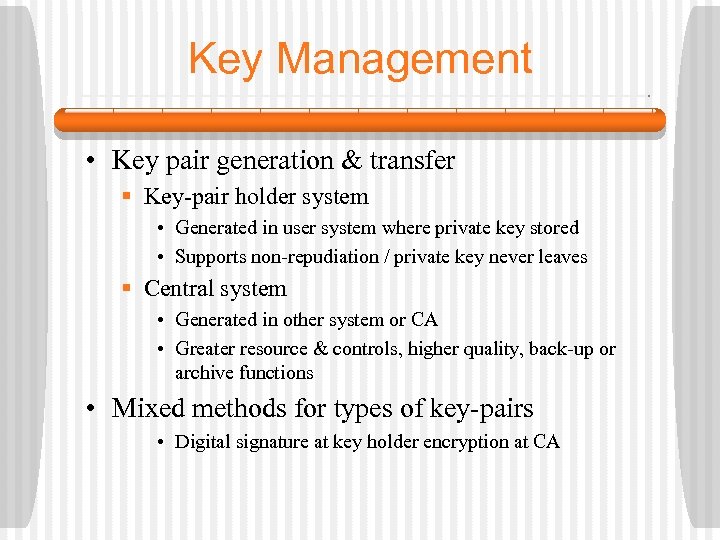
Key Management • Key pair generation & transfer § Key-pair holder system • Generated in user system where private key stored • Supports non-repudiation / private key never leaves § Central system • Generated in other system or CA • Greater resource & controls, higher quality, back-up or archive functions • Mixed methods for types of key-pairs • Digital signature at key holder encryption at CA

Key Management (cont. ) • Private-key Protection / Access Control § § Storage in tamper-resistant device (smart card) Storage in encrypted file Password or PIN for personal authentication Software control / digital wallet • Key-pair Update / policy • Different Types / Different Requirements § RSA can perform encryption & signatures • Digital sig keys - should be created & remain on system (ANSI X 9. 57); recreated as needed; no archival required • Encryption keys - backup & archival needed

Key Management (cont. ) • Other differing requirements § Encryption limits (56 -bit) restrict signature strength § Two types may have differing cryptoperiods § Not all algorithms have RSA dual properties § Private encryption keys may have to be provided to government, digital signature keys should never be

Certificate Application Process • Registration with Certificate Authority § Establish relationship & provide subscriber info § Explicitly apply & accept certificate • Authentication § Personal presence, ID documents § Use of intermediaries as local registration authorities • Distribution § Accompanying digital signature § Directory Service (X. 500 standards)
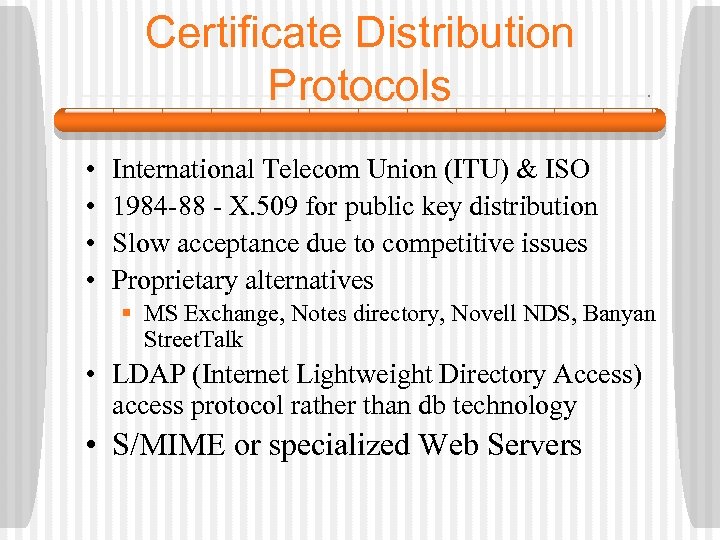
Certificate Distribution Protocols • • International Telecom Union (ITU) & ISO 1984 -88 - X. 509 for public key distribution Slow acceptance due to competitive issues Proprietary alternatives § MS Exchange, Notes directory, Novell NDS, Banyan Street. Talk • LDAP (Internet Lightweight Directory Access) access protocol rather than db technology • S/MIME or specialized Web Servers

X. 509 Certificate Format Version Serial Number Signature Algorithm ID Issuer (CA) X. 500 Name Validity Period Subject X. 500 Name Subject Public Algorithm ID Key Info Public Key Value Issuer Unique ID Subject Unique ID CA Digital Signature Version 1, 2, or 3 Unique for this certificate Used by CA (DSS w/SHA hash *) Issuing CA name Start & expiry date Holder of private key Value of holder’s public key & algorithm (RSA w/MD 5 hash *) Optional unique ID for CA Optional unique ID for holder * Object identifier
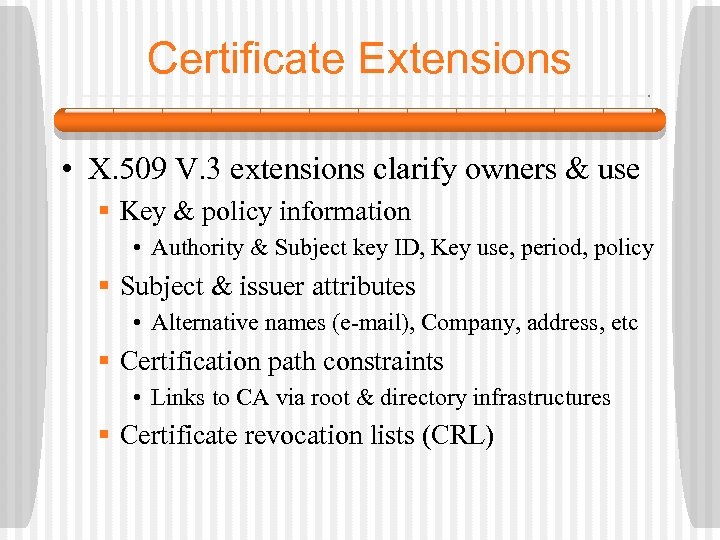
Certificate Extensions • X. 509 V. 3 extensions clarify owners & use § Key & policy information • Authority & Subject key ID, Key use, period, policy § Subject & issuer attributes • Alternative names (e-mail), Company, address, etc § Certification path constraints • Links to CA via root & directory infrastructures § Certificate revocation lists (CRL)
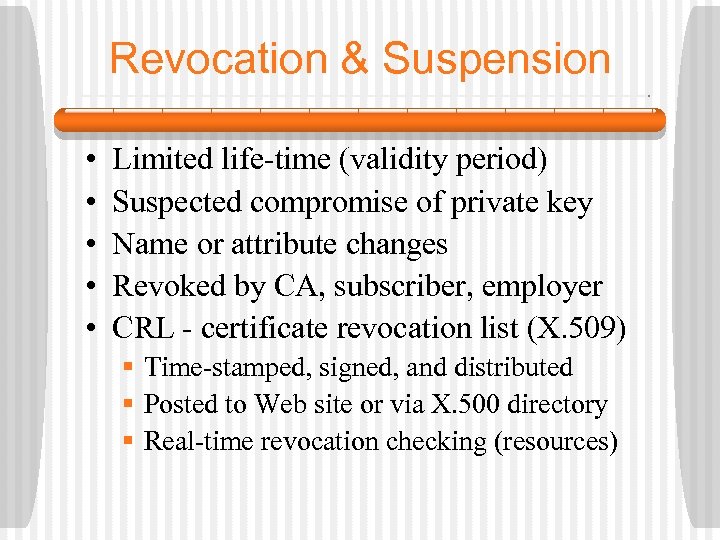
Revocation & Suspension • • • Limited life-time (validity period) Suspected compromise of private key Name or attribute changes Revoked by CA, subscriber, employer CRL - certificate revocation list (X. 509) § Time-stamped, signed, and distributed § Posted to Web site or via X. 500 directory § Real-time revocation checking (resources)
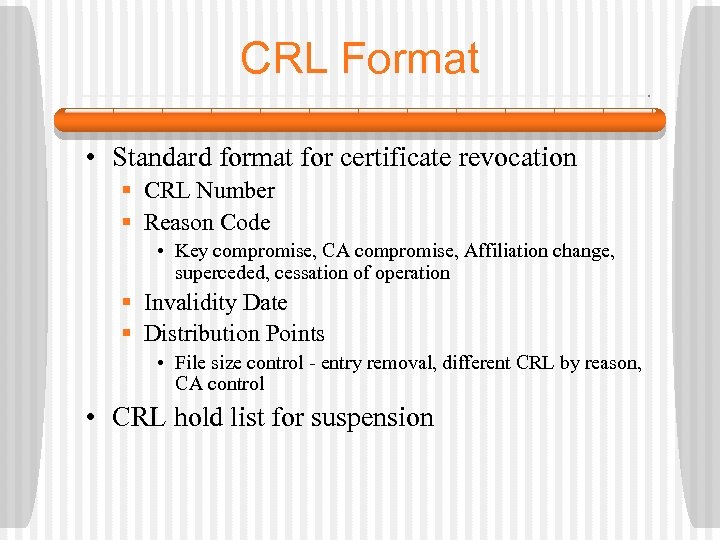
CRL Format • Standard format for certificate revocation § CRL Number § Reason Code • Key compromise, CA compromise, Affiliation change, superceded, cessation of operation § Invalidity Date § Distribution Points • File size control - entry removal, different CRL by reason, CA control • CRL hold list for suspension
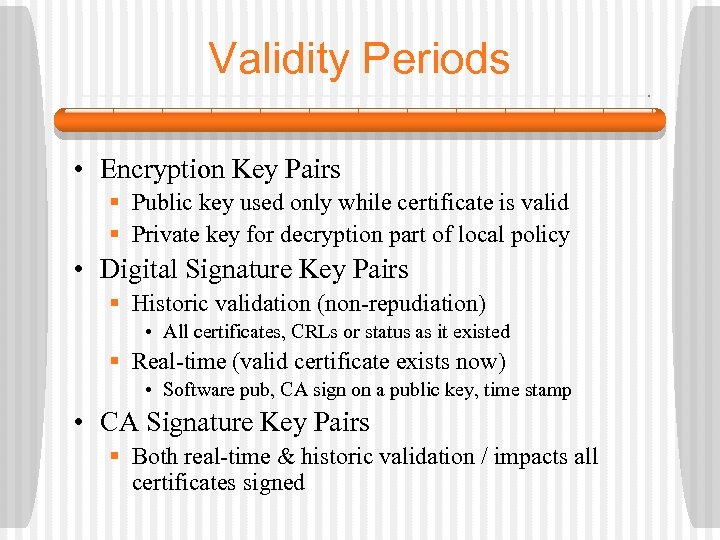
Validity Periods • Encryption Key Pairs § Public key used only while certificate is valid § Private key for decryption part of local policy • Digital Signature Key Pairs § Historic validation (non-repudiation) • All certificates, CRLs or status as it existed § Real-time (valid certificate exists now) • Software pub, CA sign on a public key, time stamp • CA Signature Key Pairs § Both real-time & historic validation / impacts all certificates signed

Certificate of Authorization • Proper use (i. e. purchasing authority) • Commit corporation, authorized official, guaranteeing authenticity (i. e. software) § Authorization information • Certificate can convey (Basic Constraints field) • CA certifying identity may not know / corp. security • Authority may change prior to validity period • Attribute Certificates (bound to certificate subject) § ANSI X 9 from financial industry / attribute authority • Privilege Attribute Certificate (passed to application server & attached to session)
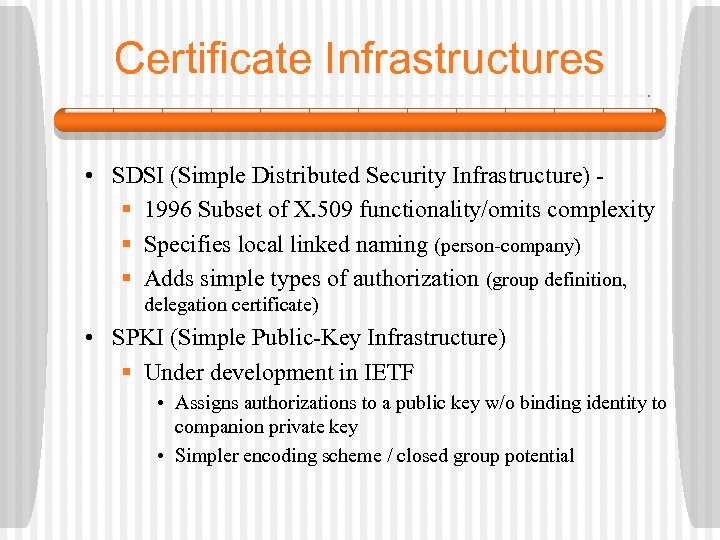
Certificate Infrastructures • SDSI (Simple Distributed Security Infrastructure) § 1996 Subset of X. 509 functionality/omits complexity § Specifies local linked naming (person-company) § Adds simple types of authorization (group definition, delegation certificate) • SPKI (Simple Public-Key Infrastructure) § Under development in IETF • Assigns authorizations to a public key w/o binding identity to companion private key • Simpler encoding scheme / closed group potential
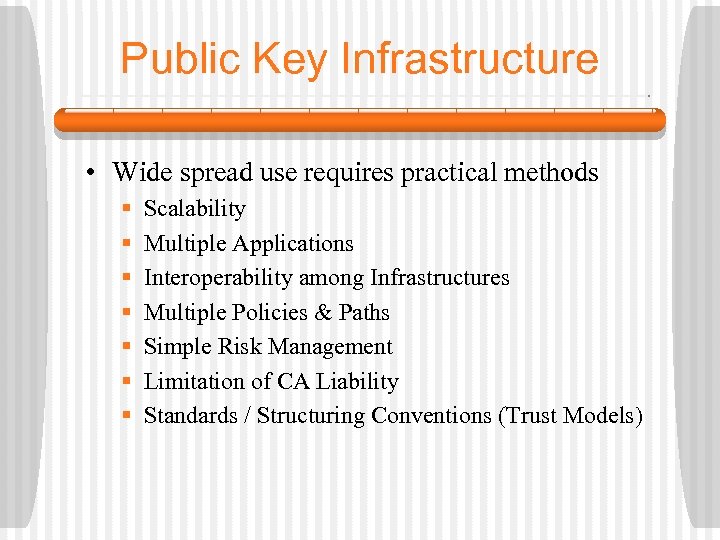
Public Key Infrastructure • Wide spread use requires practical methods § § § § Scalability Multiple Applications Interoperability among Infrastructures Multiple Policies & Paths Simple Risk Management Limitation of CA Liability Standards / Structuring Conventions (Trust Models)
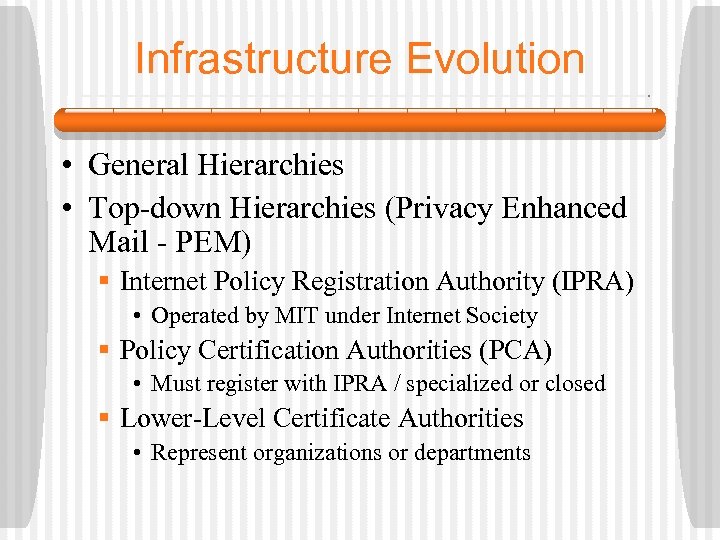
Infrastructure Evolution • General Hierarchies • Top-down Hierarchies (Privacy Enhanced Mail - PEM) § Internet Policy Registration Authority (IPRA) • Operated by MIT under Internet Society § Policy Certification Authorities (PCA) • Must register with IPRA / specialized or closed § Lower-Level Certificate Authorities • Represent organizations or departments
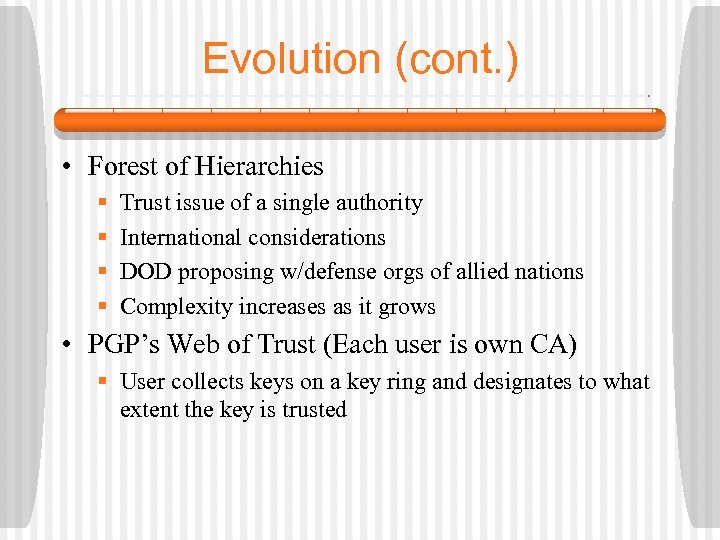
Evolution (cont. ) • Forest of Hierarchies § § Trust issue of a single authority International considerations DOD proposing w/defense orgs of allied nations Complexity increases as it grows • PGP’s Web of Trust (Each user is own CA) § User collects keys on a key ring and designates to what extent the key is trusted
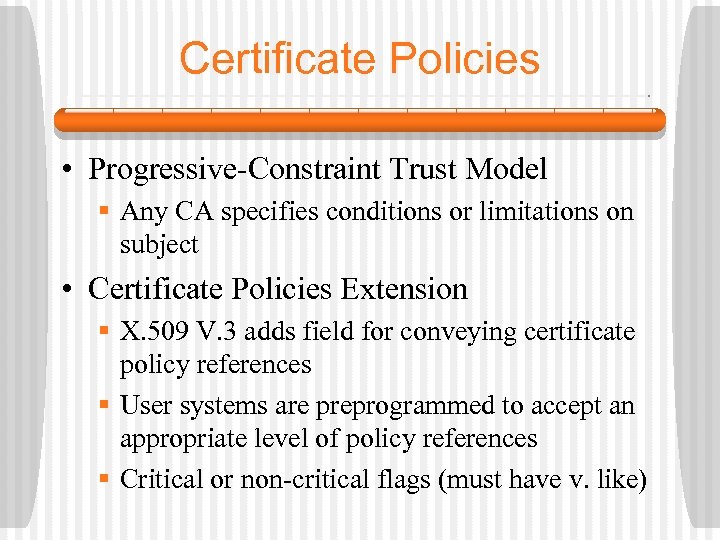
Certificate Policies • Progressive-Constraint Trust Model § Any CA specifies conditions or limitations on subject • Certificate Policies Extension § X. 509 V. 3 adds field for conveying certificate policy references § User systems are preprogrammed to accept an appropriate level of policy references § Critical or non-critical flags (must have v. like)
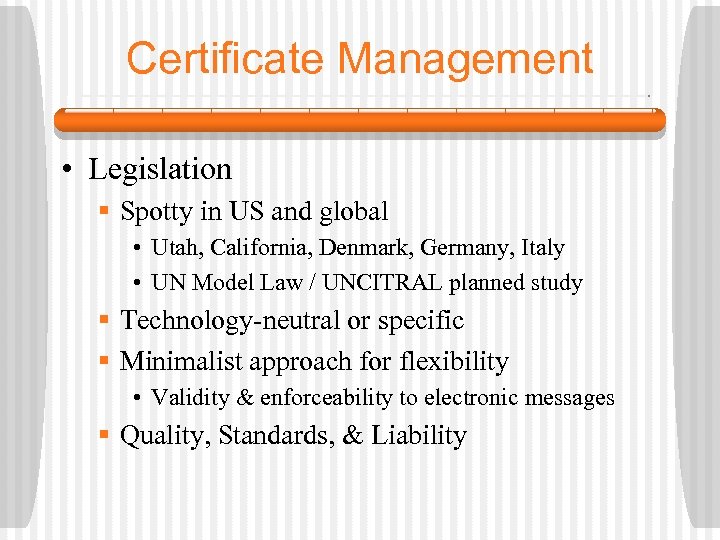
Certificate Management • Legislation § Spotty in US and global • Utah, California, Denmark, Germany, Italy • UN Model Law / UNCITRAL planned study § Technology-neutral or specific § Minimalist approach for flexibility • Validity & enforceability to electronic messages § Quality, Standards, & Liability
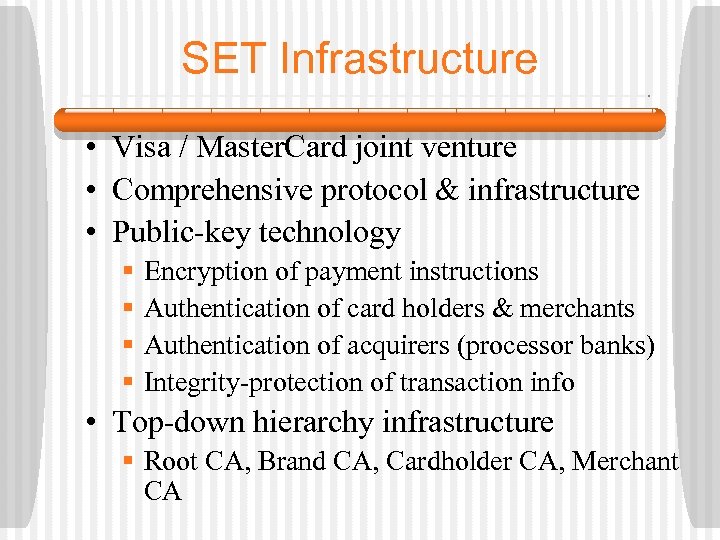
SET Infrastructure • Visa / Master. Card joint venture • Comprehensive protocol & infrastructure • Public-key technology § § Encryption of payment instructions Authentication of card holders & merchants Authentication of acquirers (processor banks) Integrity-protection of transaction info • Top-down hierarchy infrastructure § Root CA, Brand CA, Cardholder CA, Merchant CA
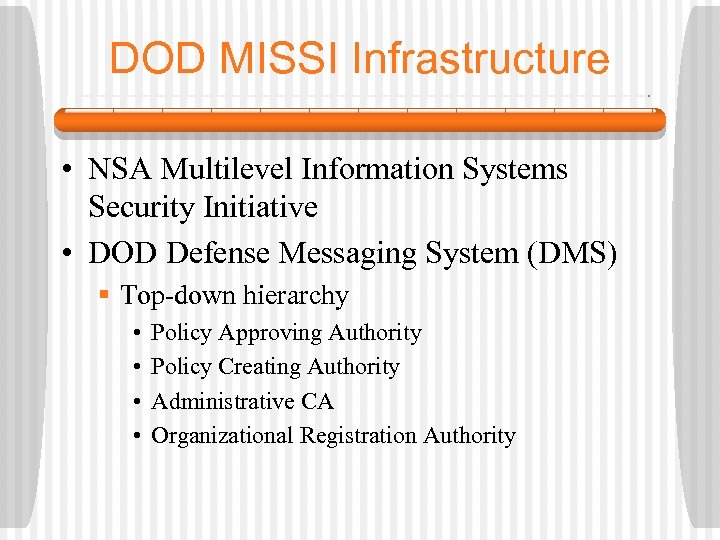
DOD MISSI Infrastructure • NSA Multilevel Information Systems Security Initiative • DOD Defense Messaging System (DMS) § Top-down hierarchy • • Policy Approving Authority Policy Creating Authority Administrative CA Organizational Registration Authority
c6e79eedbcfc9ea8afda02d82a958982.ppt